Torrens University: Data Management Case Study Report and Analysis
VerifiedAdded on 2021/06/30
|10
|2322
|46
Case Study
AI Summary
This case study report explores the implementation of a Database Management System (DBMS) for a private school in Australia. The report begins with an introduction outlining the research problem: the challenges of data management in the evolving education sector. The goal is to propose a DBMS solution to improve teaching styles and study quality. The literature review delves into the importance of DBMS, its benefits, and the impact of cloud computing. The methodology section details a descriptive research design, positivism philosophy, and an inductive approach, utilizing both quantitative and qualitative analytical techniques. The procedure outlines the steps required to implement the DBMS, including workforce, budget, and resource requirements. The report emphasizes data management operations, the use of cloud computing, and the application of tools like SPSS and SQL server. The case study aims to provide a practical framework for improving the school's data management processes and enhancing its educational offerings for its 2300 students. The report also references various sources to support the findings and recommendations.
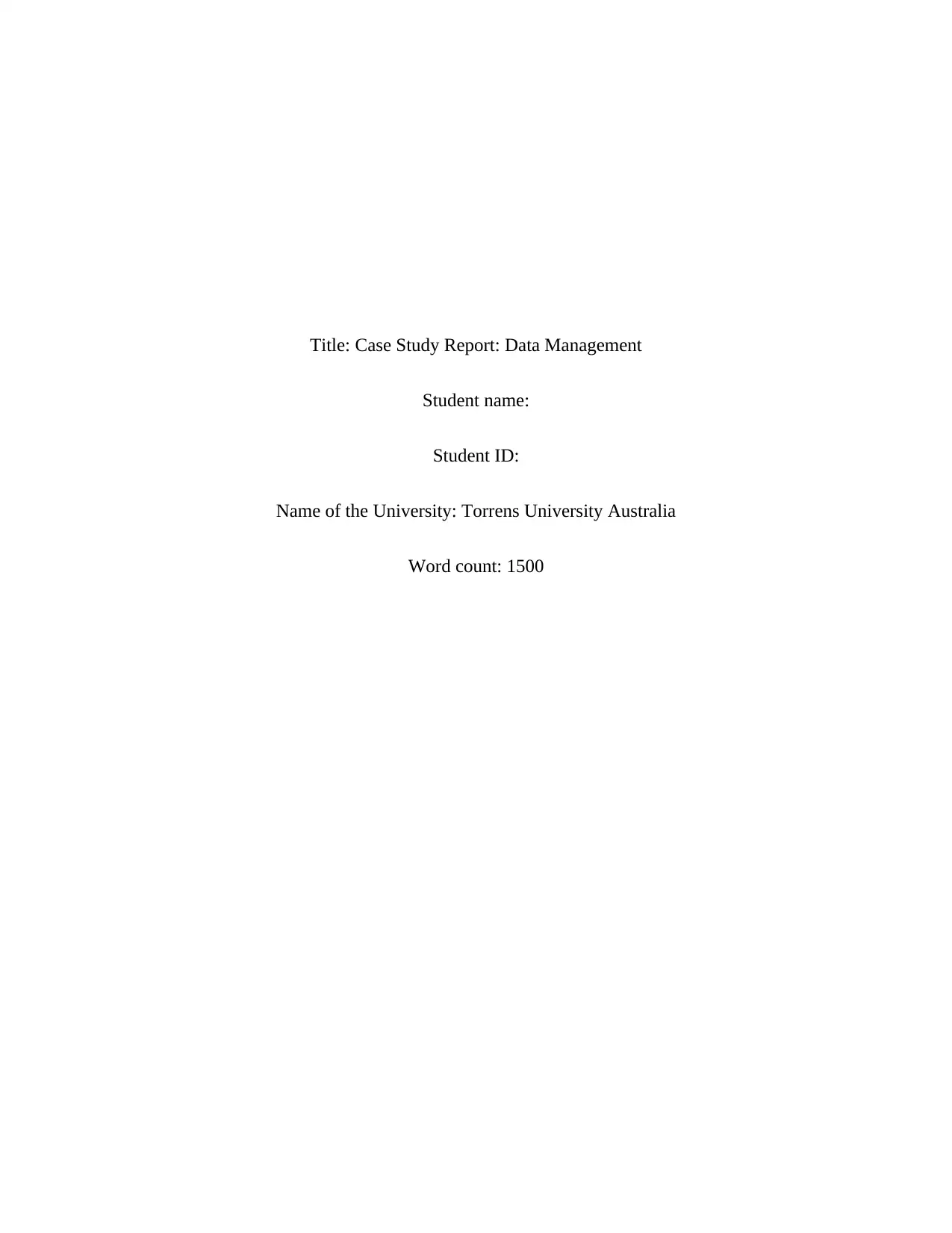
Title: Case Study Report: Data Management
Student name:
Student ID:
Name of the University: Torrens University Australia
Word count: 1500
Student name:
Student ID:
Name of the University: Torrens University Australia
Word count: 1500
Paraphrase This Document
Need a fresh take? Get an instant paraphrase of this document with our AI Paraphraser

Table of Contents
1. Introduction..................................................................................................................................3
2. Literature Review........................................................................................................................4
3. Methodology................................................................................................................................6
4. Procedure.....................................................................................................................................7
References........................................................................................................................................9
1. Introduction..................................................................................................................................3
2. Literature Review........................................................................................................................4
3. Methodology................................................................................................................................6
4. Procedure.....................................................................................................................................7
References........................................................................................................................................9
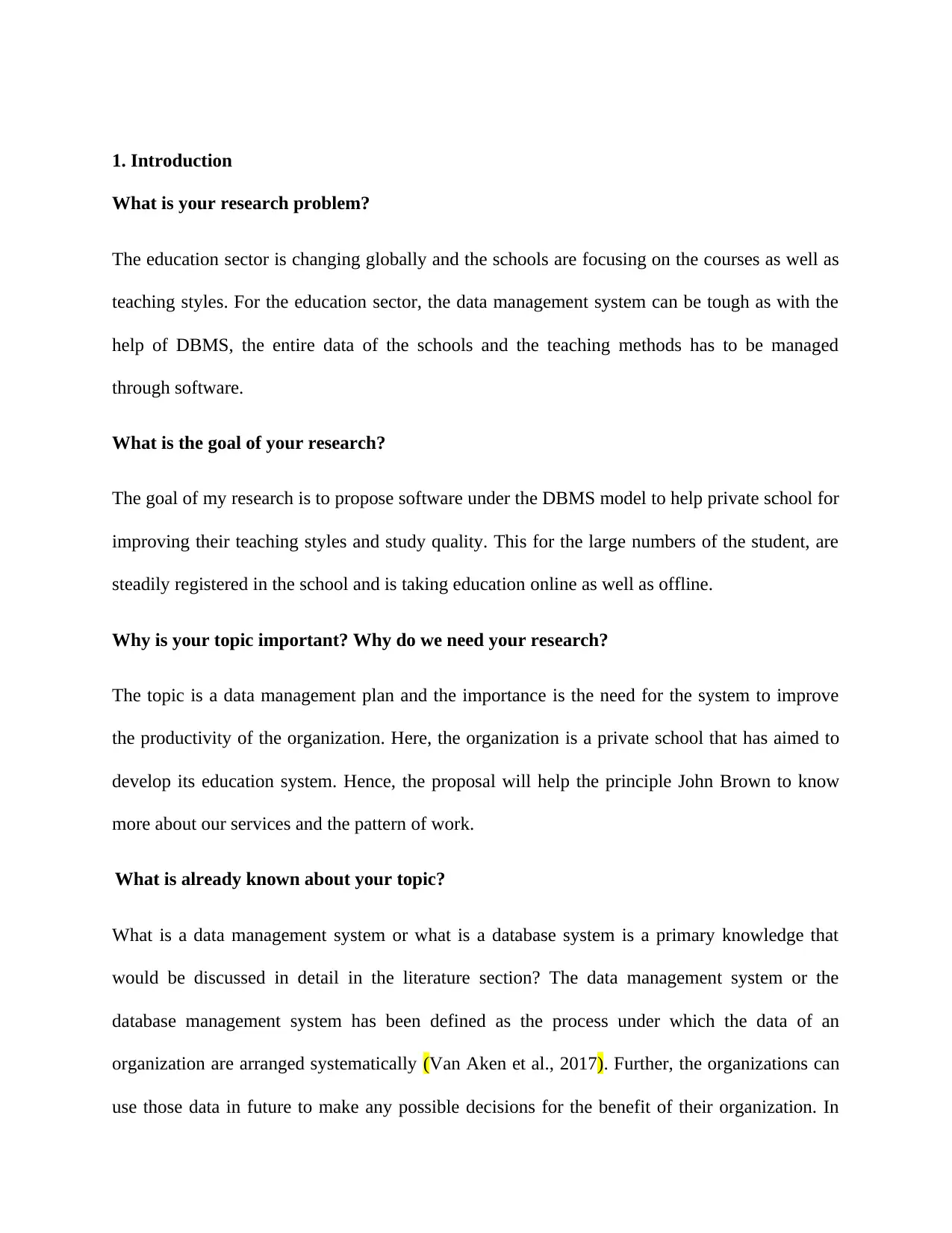
1. Introduction
What is your research problem?
The education sector is changing globally and the schools are focusing on the courses as well as
teaching styles. For the education sector, the data management system can be tough as with the
help of DBMS, the entire data of the schools and the teaching methods has to be managed
through software.
What is the goal of your research?
The goal of my research is to propose software under the DBMS model to help private school for
improving their teaching styles and study quality. This for the large numbers of the student, are
steadily registered in the school and is taking education online as well as offline.
Why is your topic important? Why do we need your research?
The topic is a data management plan and the importance is the need for the system to improve
the productivity of the organization. Here, the organization is a private school that has aimed to
develop its education system. Hence, the proposal will help the principle John Brown to know
more about our services and the pattern of work.
What is already known about your topic?
What is a data management system or what is a database system is a primary knowledge that
would be discussed in detail in the literature section? The data management system or the
database management system has been defined as the process under which the data of an
organization are arranged systematically (Van Aken et al., 2017). Further, the organizations can
use those data in future to make any possible decisions for the benefit of their organization. In
What is your research problem?
The education sector is changing globally and the schools are focusing on the courses as well as
teaching styles. For the education sector, the data management system can be tough as with the
help of DBMS, the entire data of the schools and the teaching methods has to be managed
through software.
What is the goal of your research?
The goal of my research is to propose software under the DBMS model to help private school for
improving their teaching styles and study quality. This for the large numbers of the student, are
steadily registered in the school and is taking education online as well as offline.
Why is your topic important? Why do we need your research?
The topic is a data management plan and the importance is the need for the system to improve
the productivity of the organization. Here, the organization is a private school that has aimed to
develop its education system. Hence, the proposal will help the principle John Brown to know
more about our services and the pattern of work.
What is already known about your topic?
What is a data management system or what is a database system is a primary knowledge that
would be discussed in detail in the literature section? The data management system or the
database management system has been defined as the process under which the data of an
organization are arranged systematically (Van Aken et al., 2017). Further, the organizations can
use those data in future to make any possible decisions for the benefit of their organization. In
⊘ This is a preview!⊘
Do you want full access?
Subscribe today to unlock all pages.

Trusted by 1+ million students worldwide
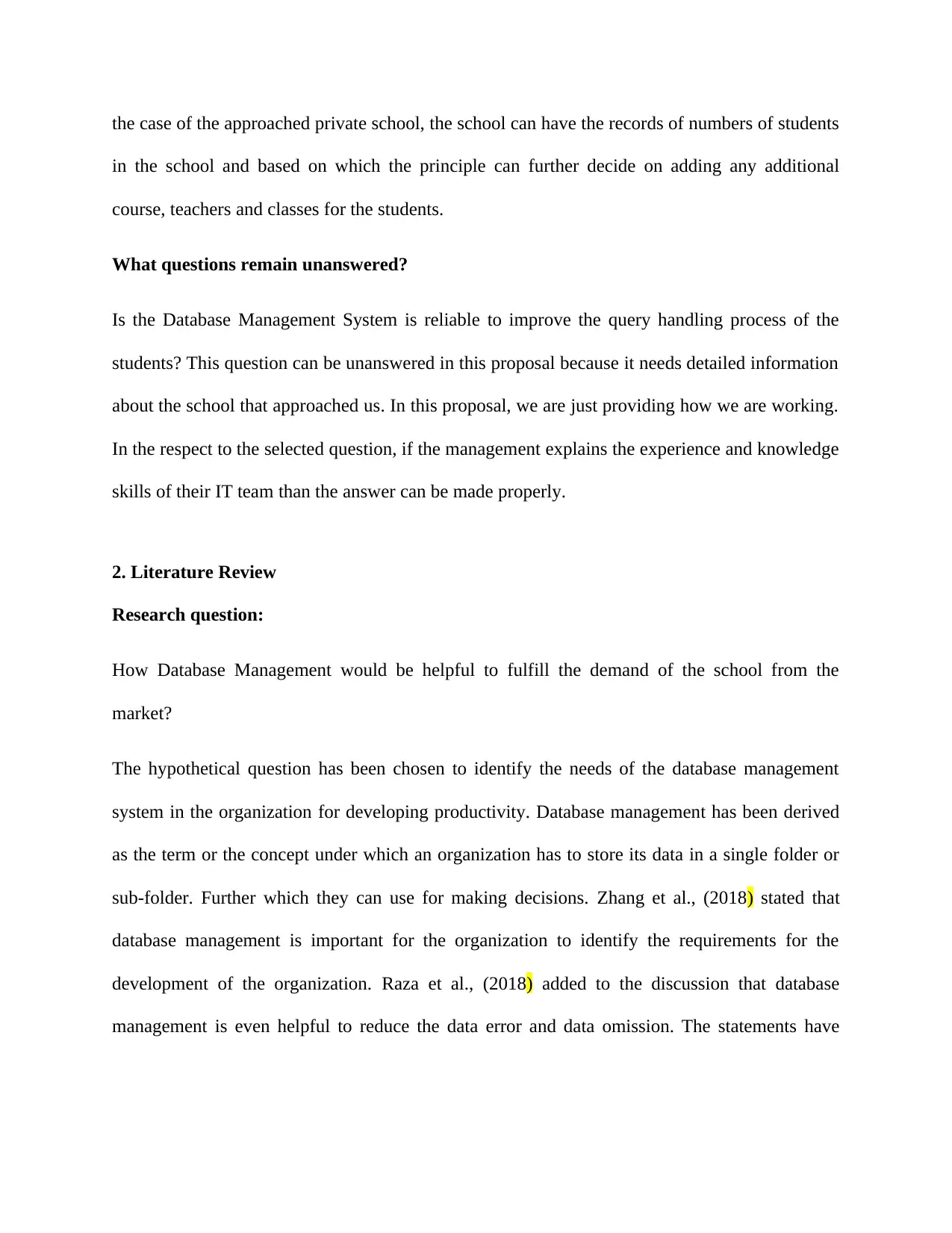
the case of the approached private school, the school can have the records of numbers of students
in the school and based on which the principle can further decide on adding any additional
course, teachers and classes for the students.
What questions remain unanswered?
Is the Database Management System is reliable to improve the query handling process of the
students? This question can be unanswered in this proposal because it needs detailed information
about the school that approached us. In this proposal, we are just providing how we are working.
In the respect to the selected question, if the management explains the experience and knowledge
skills of their IT team than the answer can be made properly.
2. Literature Review
Research question:
How Database Management would be helpful to fulfill the demand of the school from the
market?
The hypothetical question has been chosen to identify the needs of the database management
system in the organization for developing productivity. Database management has been derived
as the term or the concept under which an organization has to store its data in a single folder or
sub-folder. Further which they can use for making decisions. Zhang et al., (2018) stated that
database management is important for the organization to identify the requirements for the
development of the organization. Raza et al., (2018) added to the discussion that database
management is even helpful to reduce the data error and data omission. The statements have
in the school and based on which the principle can further decide on adding any additional
course, teachers and classes for the students.
What questions remain unanswered?
Is the Database Management System is reliable to improve the query handling process of the
students? This question can be unanswered in this proposal because it needs detailed information
about the school that approached us. In this proposal, we are just providing how we are working.
In the respect to the selected question, if the management explains the experience and knowledge
skills of their IT team than the answer can be made properly.
2. Literature Review
Research question:
How Database Management would be helpful to fulfill the demand of the school from the
market?
The hypothetical question has been chosen to identify the needs of the database management
system in the organization for developing productivity. Database management has been derived
as the term or the concept under which an organization has to store its data in a single folder or
sub-folder. Further which they can use for making decisions. Zhang et al., (2018) stated that
database management is important for the organization to identify the requirements for the
development of the organization. Raza et al., (2018) added to the discussion that database
management is even helpful to reduce the data error and data omission. The statements have
Paraphrase This Document
Need a fresh take? Get an instant paraphrase of this document with our AI Paraphraser
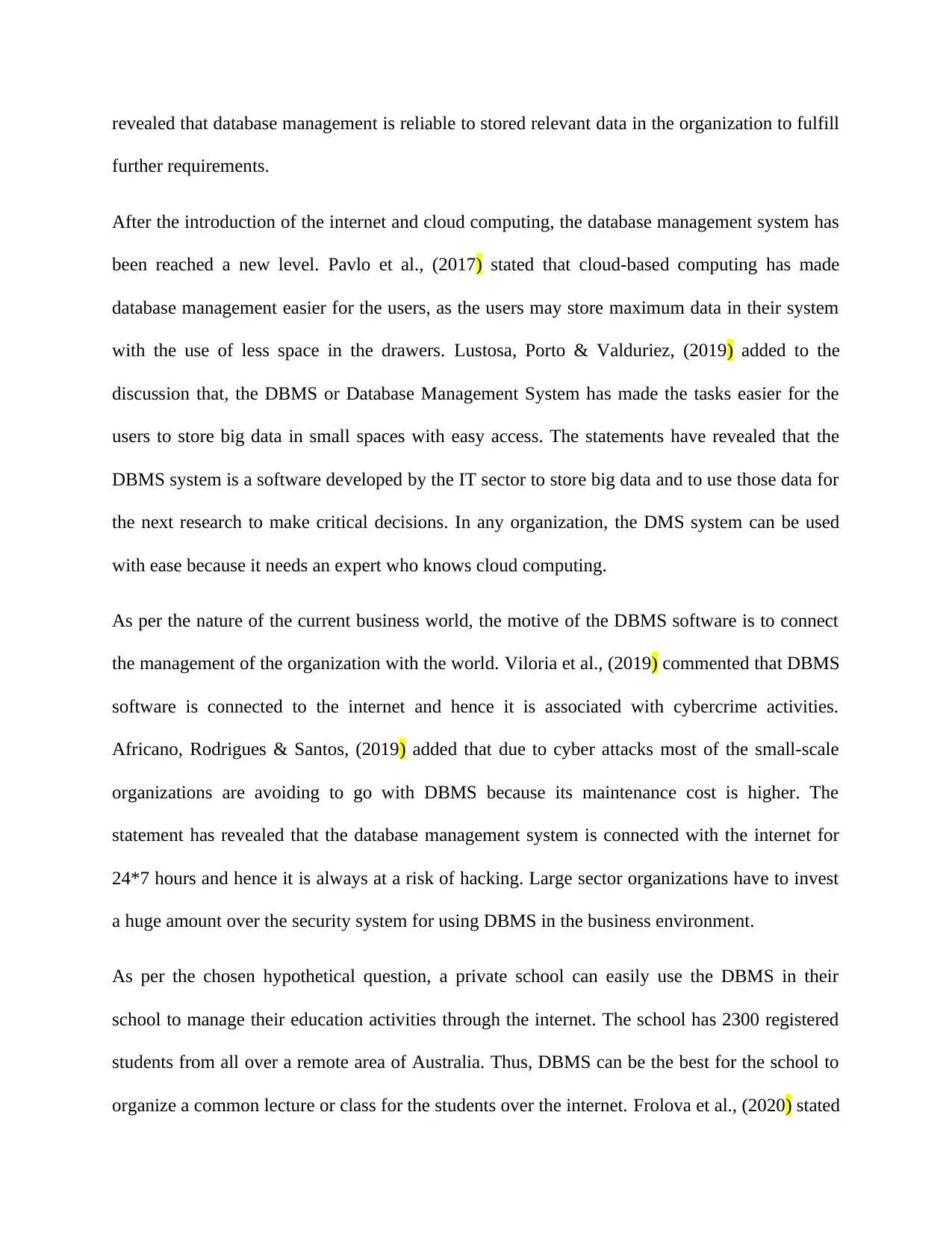
revealed that database management is reliable to stored relevant data in the organization to fulfill
further requirements.
After the introduction of the internet and cloud computing, the database management system has
been reached a new level. Pavlo et al., (2017) stated that cloud-based computing has made
database management easier for the users, as the users may store maximum data in their system
with the use of less space in the drawers. Lustosa, Porto & Valduriez, (2019) added to the
discussion that, the DBMS or Database Management System has made the tasks easier for the
users to store big data in small spaces with easy access. The statements have revealed that the
DBMS system is a software developed by the IT sector to store big data and to use those data for
the next research to make critical decisions. In any organization, the DMS system can be used
with ease because it needs an expert who knows cloud computing.
As per the nature of the current business world, the motive of the DBMS software is to connect
the management of the organization with the world. Viloria et al., (2019) commented that DBMS
software is connected to the internet and hence it is associated with cybercrime activities.
Africano, Rodrigues & Santos, (2019) added that due to cyber attacks most of the small-scale
organizations are avoiding to go with DBMS because its maintenance cost is higher. The
statement has revealed that the database management system is connected with the internet for
24*7 hours and hence it is always at a risk of hacking. Large sector organizations have to invest
a huge amount over the security system for using DBMS in the business environment.
As per the chosen hypothetical question, a private school can easily use the DBMS in their
school to manage their education activities through the internet. The school has 2300 registered
students from all over a remote area of Australia. Thus, DBMS can be the best for the school to
organize a common lecture or class for the students over the internet. Frolova et al., (2020) stated
further requirements.
After the introduction of the internet and cloud computing, the database management system has
been reached a new level. Pavlo et al., (2017) stated that cloud-based computing has made
database management easier for the users, as the users may store maximum data in their system
with the use of less space in the drawers. Lustosa, Porto & Valduriez, (2019) added to the
discussion that, the DBMS or Database Management System has made the tasks easier for the
users to store big data in small spaces with easy access. The statements have revealed that the
DBMS system is a software developed by the IT sector to store big data and to use those data for
the next research to make critical decisions. In any organization, the DMS system can be used
with ease because it needs an expert who knows cloud computing.
As per the nature of the current business world, the motive of the DBMS software is to connect
the management of the organization with the world. Viloria et al., (2019) commented that DBMS
software is connected to the internet and hence it is associated with cybercrime activities.
Africano, Rodrigues & Santos, (2019) added that due to cyber attacks most of the small-scale
organizations are avoiding to go with DBMS because its maintenance cost is higher. The
statement has revealed that the database management system is connected with the internet for
24*7 hours and hence it is always at a risk of hacking. Large sector organizations have to invest
a huge amount over the security system for using DBMS in the business environment.
As per the chosen hypothetical question, a private school can easily use the DBMS in their
school to manage their education activities through the internet. The school has 2300 registered
students from all over a remote area of Australia. Thus, DBMS can be the best for the school to
organize a common lecture or class for the students over the internet. Frolova et al., (2020) stated
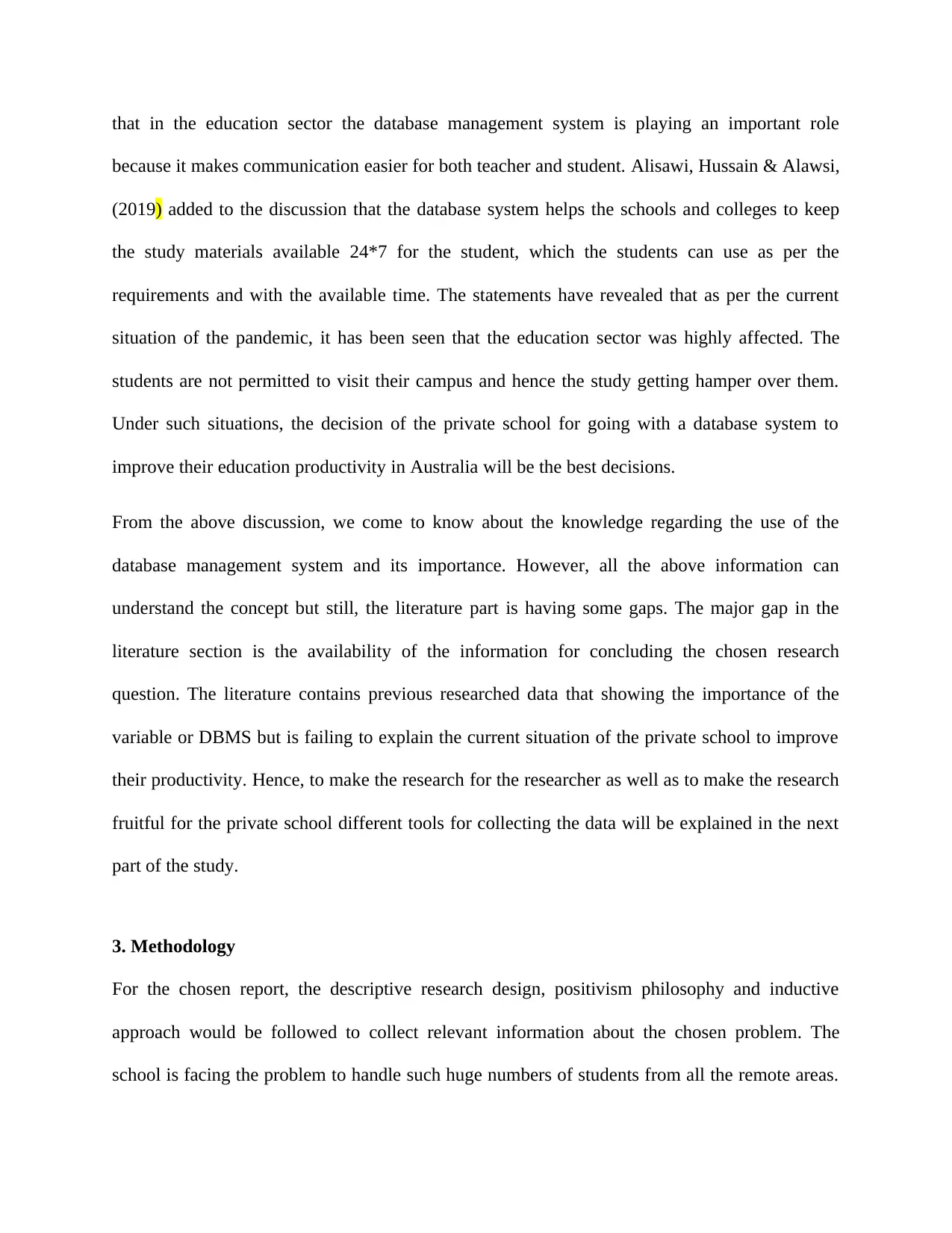
that in the education sector the database management system is playing an important role
because it makes communication easier for both teacher and student. Alisawi, Hussain & Alawsi,
(2019) added to the discussion that the database system helps the schools and colleges to keep
the study materials available 24*7 for the student, which the students can use as per the
requirements and with the available time. The statements have revealed that as per the current
situation of the pandemic, it has been seen that the education sector was highly affected. The
students are not permitted to visit their campus and hence the study getting hamper over them.
Under such situations, the decision of the private school for going with a database system to
improve their education productivity in Australia will be the best decisions.
From the above discussion, we come to know about the knowledge regarding the use of the
database management system and its importance. However, all the above information can
understand the concept but still, the literature part is having some gaps. The major gap in the
literature section is the availability of the information for concluding the chosen research
question. The literature contains previous researched data that showing the importance of the
variable or DBMS but is failing to explain the current situation of the private school to improve
their productivity. Hence, to make the research for the researcher as well as to make the research
fruitful for the private school different tools for collecting the data will be explained in the next
part of the study.
3. Methodology
For the chosen report, the descriptive research design, positivism philosophy and inductive
approach would be followed to collect relevant information about the chosen problem. The
school is facing the problem to handle such huge numbers of students from all the remote areas.
because it makes communication easier for both teacher and student. Alisawi, Hussain & Alawsi,
(2019) added to the discussion that the database system helps the schools and colleges to keep
the study materials available 24*7 for the student, which the students can use as per the
requirements and with the available time. The statements have revealed that as per the current
situation of the pandemic, it has been seen that the education sector was highly affected. The
students are not permitted to visit their campus and hence the study getting hamper over them.
Under such situations, the decision of the private school for going with a database system to
improve their education productivity in Australia will be the best decisions.
From the above discussion, we come to know about the knowledge regarding the use of the
database management system and its importance. However, all the above information can
understand the concept but still, the literature part is having some gaps. The major gap in the
literature section is the availability of the information for concluding the chosen research
question. The literature contains previous researched data that showing the importance of the
variable or DBMS but is failing to explain the current situation of the private school to improve
their productivity. Hence, to make the research for the researcher as well as to make the research
fruitful for the private school different tools for collecting the data will be explained in the next
part of the study.
3. Methodology
For the chosen report, the descriptive research design, positivism philosophy and inductive
approach would be followed to collect relevant information about the chosen problem. The
school is facing the problem to handle such huge numbers of students from all the remote areas.
⊘ This is a preview!⊘
Do you want full access?
Subscribe today to unlock all pages.

Trusted by 1+ million students worldwide
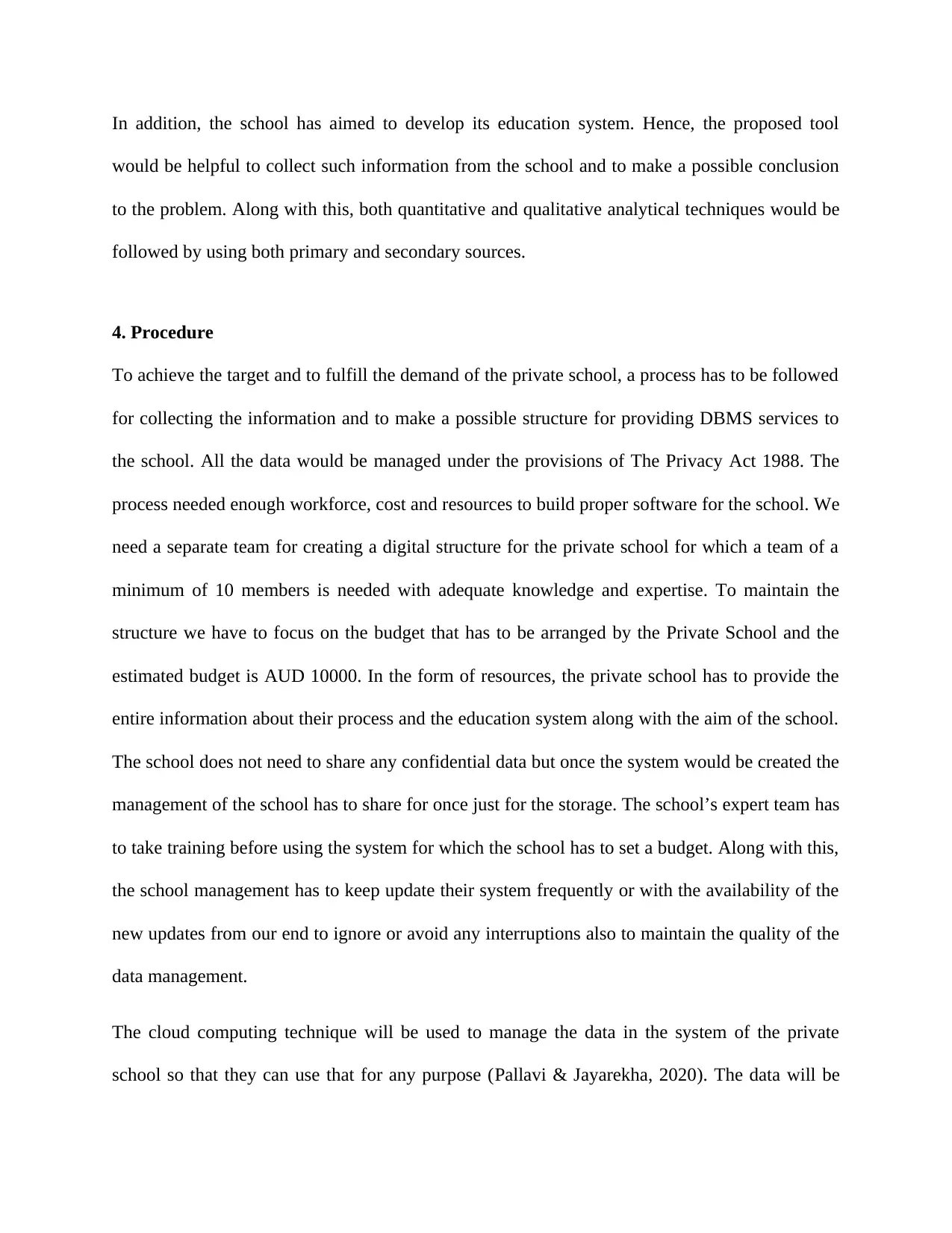
In addition, the school has aimed to develop its education system. Hence, the proposed tool
would be helpful to collect such information from the school and to make a possible conclusion
to the problem. Along with this, both quantitative and qualitative analytical techniques would be
followed by using both primary and secondary sources.
4. Procedure
To achieve the target and to fulfill the demand of the private school, a process has to be followed
for collecting the information and to make a possible structure for providing DBMS services to
the school. All the data would be managed under the provisions of The Privacy Act 1988. The
process needed enough workforce, cost and resources to build proper software for the school. We
need a separate team for creating a digital structure for the private school for which a team of a
minimum of 10 members is needed with adequate knowledge and expertise. To maintain the
structure we have to focus on the budget that has to be arranged by the Private School and the
estimated budget is AUD 10000. In the form of resources, the private school has to provide the
entire information about their process and the education system along with the aim of the school.
The school does not need to share any confidential data but once the system would be created the
management of the school has to share for once just for the storage. The school’s expert team has
to take training before using the system for which the school has to set a budget. Along with this,
the school management has to keep update their system frequently or with the availability of the
new updates from our end to ignore or avoid any interruptions also to maintain the quality of the
data management.
The cloud computing technique will be used to manage the data in the system of the private
school so that they can use that for any purpose (Pallavi & Jayarekha, 2020). The data will be
would be helpful to collect such information from the school and to make a possible conclusion
to the problem. Along with this, both quantitative and qualitative analytical techniques would be
followed by using both primary and secondary sources.
4. Procedure
To achieve the target and to fulfill the demand of the private school, a process has to be followed
for collecting the information and to make a possible structure for providing DBMS services to
the school. All the data would be managed under the provisions of The Privacy Act 1988. The
process needed enough workforce, cost and resources to build proper software for the school. We
need a separate team for creating a digital structure for the private school for which a team of a
minimum of 10 members is needed with adequate knowledge and expertise. To maintain the
structure we have to focus on the budget that has to be arranged by the Private School and the
estimated budget is AUD 10000. In the form of resources, the private school has to provide the
entire information about their process and the education system along with the aim of the school.
The school does not need to share any confidential data but once the system would be created the
management of the school has to share for once just for the storage. The school’s expert team has
to take training before using the system for which the school has to set a budget. Along with this,
the school management has to keep update their system frequently or with the availability of the
new updates from our end to ignore or avoid any interruptions also to maintain the quality of the
data management.
The cloud computing technique will be used to manage the data in the system of the private
school so that they can use that for any purpose (Pallavi & Jayarekha, 2020). The data will be
Paraphrase This Document
Need a fresh take? Get an instant paraphrase of this document with our AI Paraphraser
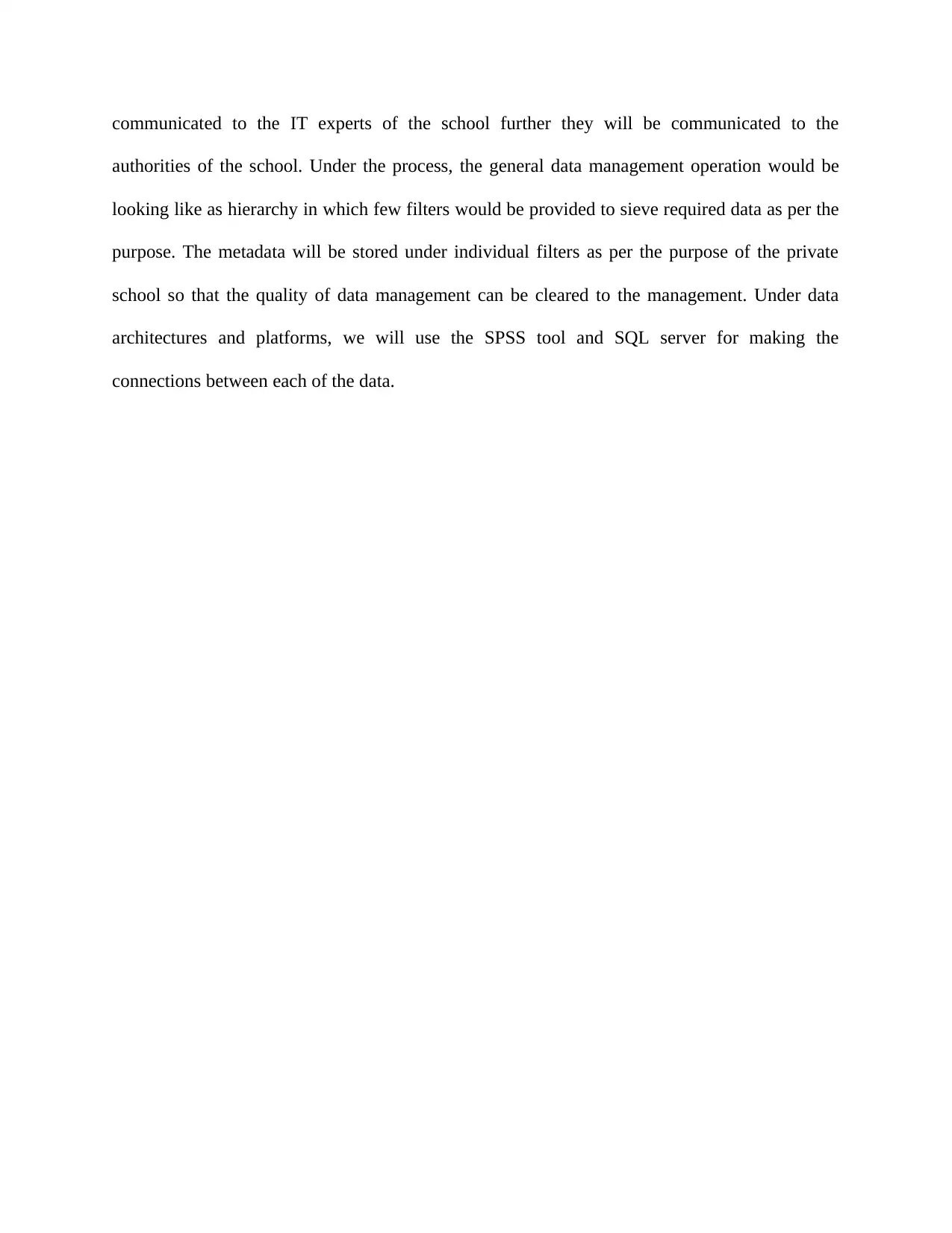
communicated to the IT experts of the school further they will be communicated to the
authorities of the school. Under the process, the general data management operation would be
looking like as hierarchy in which few filters would be provided to sieve required data as per the
purpose. The metadata will be stored under individual filters as per the purpose of the private
school so that the quality of data management can be cleared to the management. Under data
architectures and platforms, we will use the SPSS tool and SQL server for making the
connections between each of the data.
authorities of the school. Under the process, the general data management operation would be
looking like as hierarchy in which few filters would be provided to sieve required data as per the
purpose. The metadata will be stored under individual filters as per the purpose of the private
school so that the quality of data management can be cleared to the management. Under data
architectures and platforms, we will use the SPSS tool and SQL server for making the
connections between each of the data.
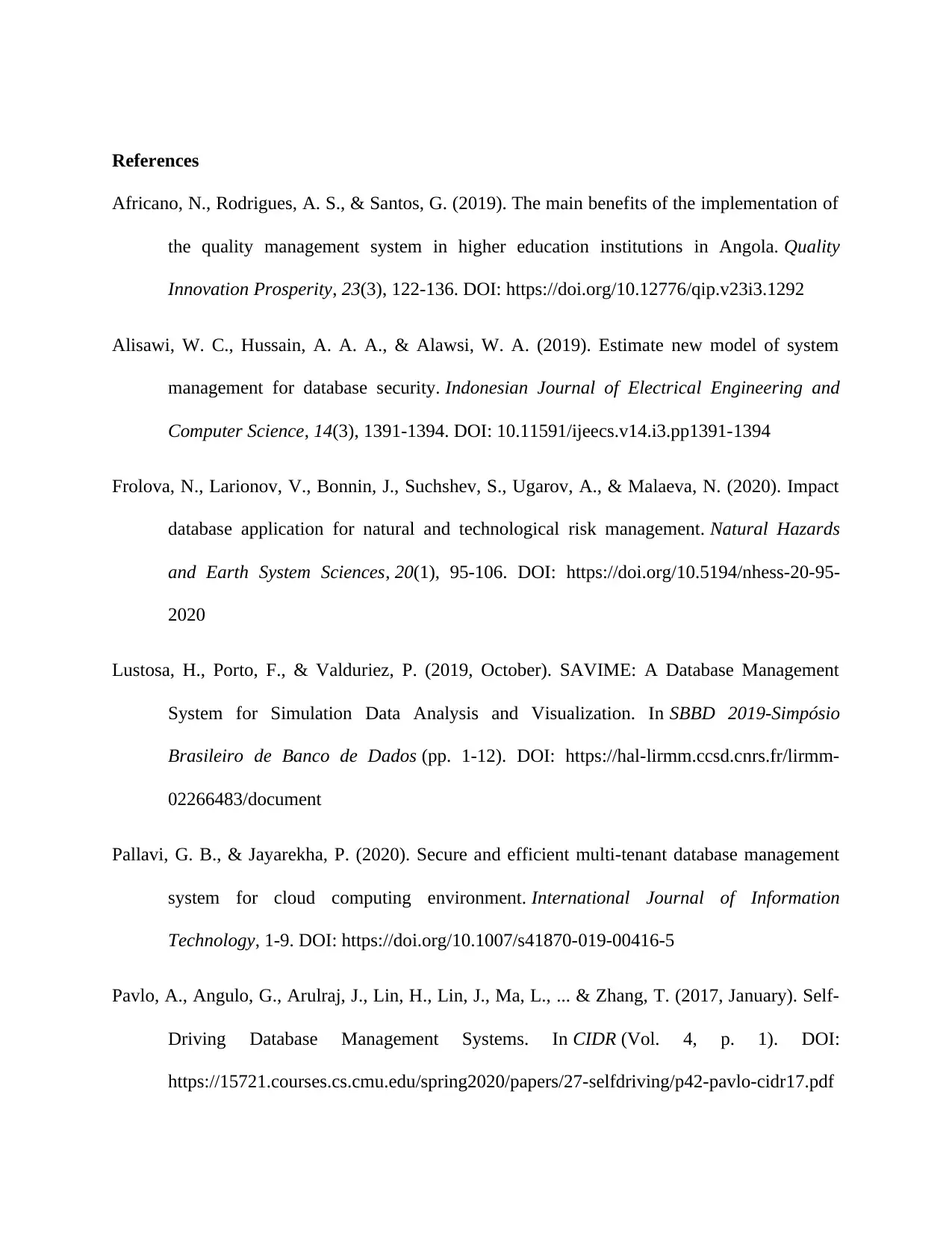
References
Africano, N., Rodrigues, A. S., & Santos, G. (2019). The main benefits of the implementation of
the quality management system in higher education institutions in Angola. Quality
Innovation Prosperity, 23(3), 122-136. DOI: https://doi.org/10.12776/qip.v23i3.1292
Alisawi, W. C., Hussain, A. A. A., & Alawsi, W. A. (2019). Estimate new model of system
management for database security. Indonesian Journal of Electrical Engineering and
Computer Science, 14(3), 1391-1394. DOI: 10.11591/ijeecs.v14.i3.pp1391-1394
Frolova, N., Larionov, V., Bonnin, J., Suchshev, S., Ugarov, A., & Malaeva, N. (2020). Impact
database application for natural and technological risk management. Natural Hazards
and Earth System Sciences, 20(1), 95-106. DOI: https://doi.org/10.5194/nhess-20-95-
2020
Lustosa, H., Porto, F., & Valduriez, P. (2019, October). SAVIME: A Database Management
System for Simulation Data Analysis and Visualization. In SBBD 2019-Simpósio
Brasileiro de Banco de Dados (pp. 1-12). DOI: https://hal-lirmm.ccsd.cnrs.fr/lirmm-
02266483/document
Pallavi, G. B., & Jayarekha, P. (2020). Secure and efficient multi-tenant database management
system for cloud computing environment. International Journal of Information
Technology, 1-9. DOI: https://doi.org/10.1007/s41870-019-00416-5
Pavlo, A., Angulo, G., Arulraj, J., Lin, H., Lin, J., Ma, L., ... & Zhang, T. (2017, January). Self-
Driving Database Management Systems. In CIDR (Vol. 4, p. 1). DOI:
https://15721.courses.cs.cmu.edu/spring2020/papers/27-selfdriving/p42-pavlo-cidr17.pdf
Africano, N., Rodrigues, A. S., & Santos, G. (2019). The main benefits of the implementation of
the quality management system in higher education institutions in Angola. Quality
Innovation Prosperity, 23(3), 122-136. DOI: https://doi.org/10.12776/qip.v23i3.1292
Alisawi, W. C., Hussain, A. A. A., & Alawsi, W. A. (2019). Estimate new model of system
management for database security. Indonesian Journal of Electrical Engineering and
Computer Science, 14(3), 1391-1394. DOI: 10.11591/ijeecs.v14.i3.pp1391-1394
Frolova, N., Larionov, V., Bonnin, J., Suchshev, S., Ugarov, A., & Malaeva, N. (2020). Impact
database application for natural and technological risk management. Natural Hazards
and Earth System Sciences, 20(1), 95-106. DOI: https://doi.org/10.5194/nhess-20-95-
2020
Lustosa, H., Porto, F., & Valduriez, P. (2019, October). SAVIME: A Database Management
System for Simulation Data Analysis and Visualization. In SBBD 2019-Simpósio
Brasileiro de Banco de Dados (pp. 1-12). DOI: https://hal-lirmm.ccsd.cnrs.fr/lirmm-
02266483/document
Pallavi, G. B., & Jayarekha, P. (2020). Secure and efficient multi-tenant database management
system for cloud computing environment. International Journal of Information
Technology, 1-9. DOI: https://doi.org/10.1007/s41870-019-00416-5
Pavlo, A., Angulo, G., Arulraj, J., Lin, H., Lin, J., Ma, L., ... & Zhang, T. (2017, January). Self-
Driving Database Management Systems. In CIDR (Vol. 4, p. 1). DOI:
https://15721.courses.cs.cmu.edu/spring2020/papers/27-selfdriving/p42-pavlo-cidr17.pdf
⊘ This is a preview!⊘
Do you want full access?
Subscribe today to unlock all pages.

Trusted by 1+ million students worldwide
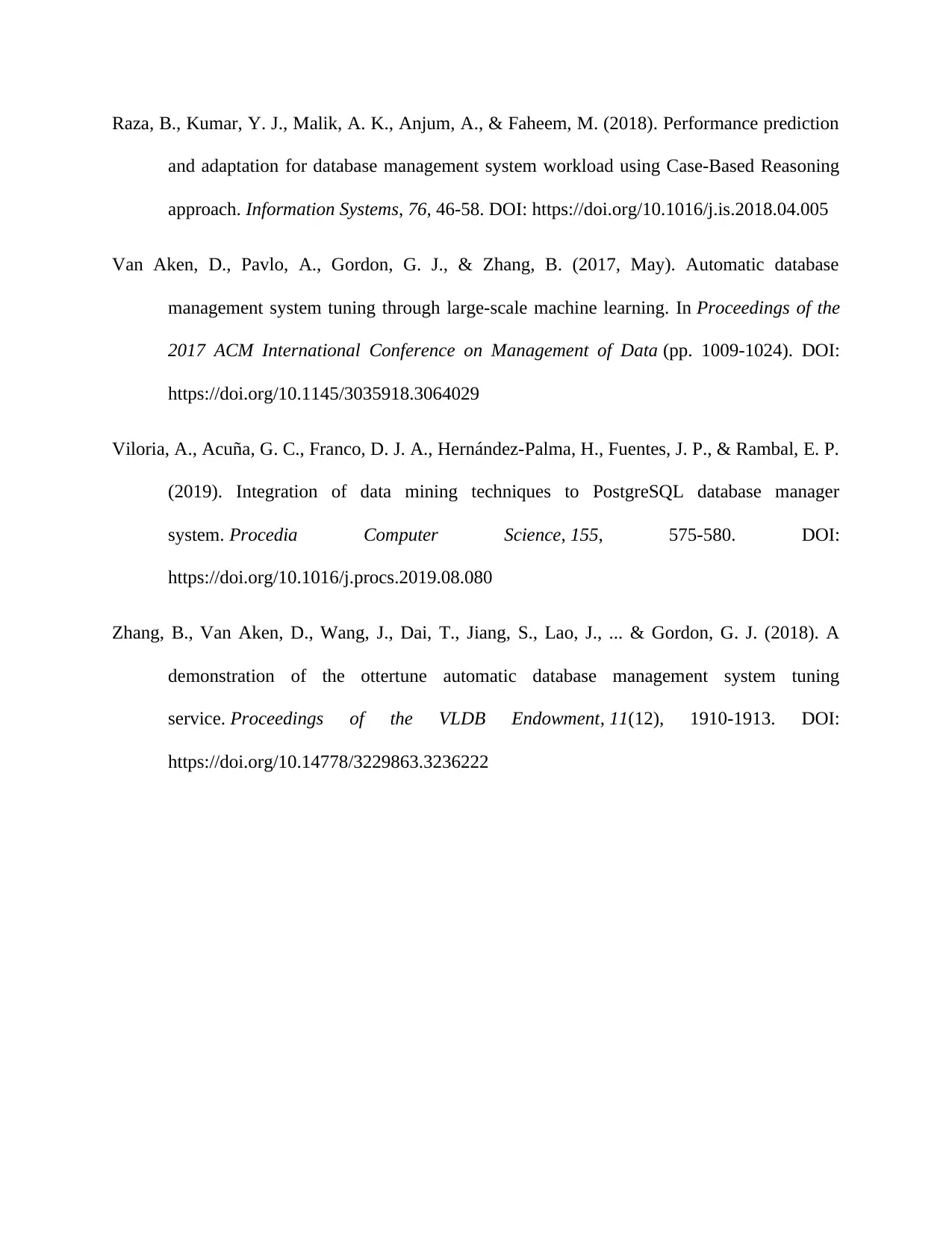
Raza, B., Kumar, Y. J., Malik, A. K., Anjum, A., & Faheem, M. (2018). Performance prediction
and adaptation for database management system workload using Case-Based Reasoning
approach. Information Systems, 76, 46-58. DOI: https://doi.org/10.1016/j.is.2018.04.005
Van Aken, D., Pavlo, A., Gordon, G. J., & Zhang, B. (2017, May). Automatic database
management system tuning through large-scale machine learning. In Proceedings of the
2017 ACM International Conference on Management of Data (pp. 1009-1024). DOI:
https://doi.org/10.1145/3035918.3064029
Viloria, A., Acuña, G. C., Franco, D. J. A., Hernández-Palma, H., Fuentes, J. P., & Rambal, E. P.
(2019). Integration of data mining techniques to PostgreSQL database manager
system. Procedia Computer Science, 155, 575-580. DOI:
https://doi.org/10.1016/j.procs.2019.08.080
Zhang, B., Van Aken, D., Wang, J., Dai, T., Jiang, S., Lao, J., ... & Gordon, G. J. (2018). A
demonstration of the ottertune automatic database management system tuning
service. Proceedings of the VLDB Endowment, 11(12), 1910-1913. DOI:
https://doi.org/10.14778/3229863.3236222
and adaptation for database management system workload using Case-Based Reasoning
approach. Information Systems, 76, 46-58. DOI: https://doi.org/10.1016/j.is.2018.04.005
Van Aken, D., Pavlo, A., Gordon, G. J., & Zhang, B. (2017, May). Automatic database
management system tuning through large-scale machine learning. In Proceedings of the
2017 ACM International Conference on Management of Data (pp. 1009-1024). DOI:
https://doi.org/10.1145/3035918.3064029
Viloria, A., Acuña, G. C., Franco, D. J. A., Hernández-Palma, H., Fuentes, J. P., & Rambal, E. P.
(2019). Integration of data mining techniques to PostgreSQL database manager
system. Procedia Computer Science, 155, 575-580. DOI:
https://doi.org/10.1016/j.procs.2019.08.080
Zhang, B., Van Aken, D., Wang, J., Dai, T., Jiang, S., Lao, J., ... & Gordon, G. J. (2018). A
demonstration of the ottertune automatic database management system tuning
service. Proceedings of the VLDB Endowment, 11(12), 1910-1913. DOI:
https://doi.org/10.14778/3229863.3236222
1 out of 10
Related Documents
Your All-in-One AI-Powered Toolkit for Academic Success.
+13062052269
info@desklib.com
Available 24*7 on WhatsApp / Email
![[object Object]](/_next/static/media/star-bottom.7253800d.svg)
Unlock your academic potential
Copyright © 2020–2025 A2Z Services. All Rights Reserved. Developed and managed by ZUCOL.




